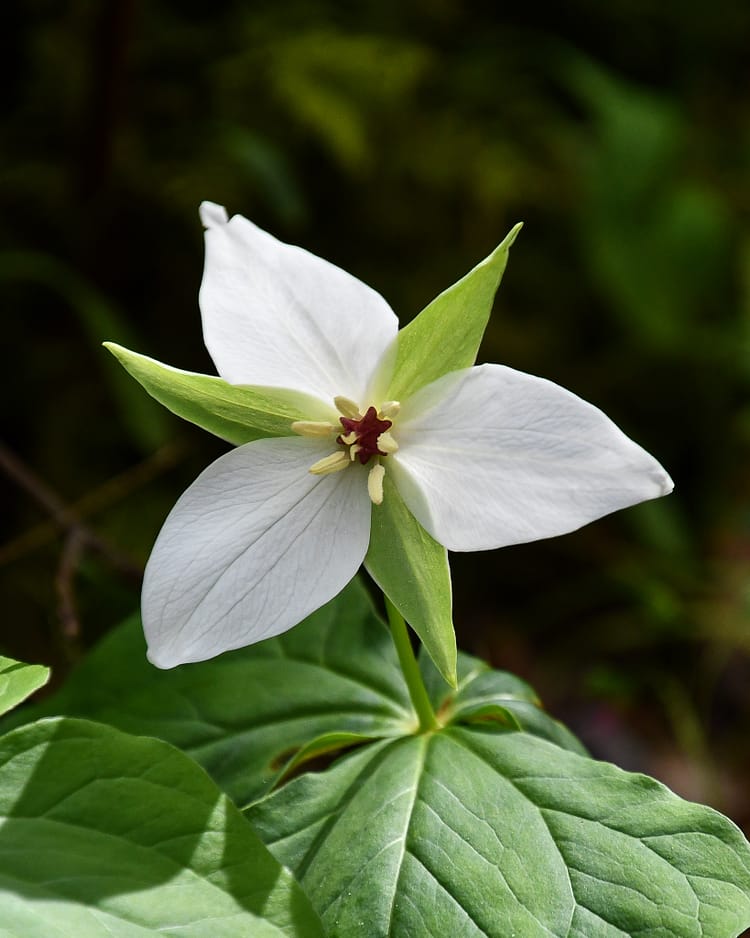The last weekend of March found us searching for spring wildflowers and a place to hike and camp where we could safely social distance. We focused in on two locations, hiking about 8 miles in the Pisgah National Forest with proximity to the Appalachian Trail. The next day, we visited the Sampson Mountain wilderness of the Cherokee National Forest. However, people were not social distancing in Tennessee, so we didn’t venture far there except for one trail where we were the only hikers. https://www.fs.usda.gov/features/going-outdoors-while-social-distancing
Rich cove forest plant community
Wakerobin Trillium comes in a purple and white form, with the three petals alternating with green sepals. It is so abundant in this area of the Pisgah National Forest, quickly towering over other spring ephemerals.


Hepatica is always a welcome sight, with two different shapes of the leaves: acute-lobed and round-lobed. What I like best about Hepatica is the varied colors of the flowers, ranging from white to pale pink to light blue. Their leaves are beautiful and visible all year long, so you know where you can find them when spring arrives.

I love the blue color of this Hepatica, with wiry stamens going in every direction! https://hikescape.org/fork-ridge-appalachian-trail-baxter-cliffs/

Fiddlehead ferns are beginning to roll out their spirals as the springtime weather entices them from the soil. Soon, the ferns will take over the spring ephemerals.

Bishops cap, or miterwort, sends up a long stalk, with tiny white fringed cups. These flowers are about 1/4 inch in diameter. The stalks pitch wildly about if there is any breeze, so I always celebrate if some flowers are in focus!

Another absolutely gorgeous spring flower that has leaves visible in the winter is Trout Lily. Aptly named for the speckled leaves, Trout Lily sends up these stunning flowers with recurved petals, revealing the vermilion stamens below.

As the flower ages, the underside of the petals take on a lighter hue of salmon, burnishing the deep golden petals before they become frayed and spent.

Cut leaf toothwort has a spray of blooms rising above the finely cut leaves. The flowers open white and deepen to pink.

Here is a herbaceous plant that I rarely see: Wild Ginger. Notice the phallic bud at the apex of the leaves. This will become the brownish-urn shaped flower. This does not produce ginger, but the roots have the scent of ginger.

Cherokee National Forest
We did find one area that was remote and unpopulated in Tennessee, and we began a short 2.5 mile trek up towards the Appalachian Trail. We were in the pine-oak-heath plant community where it was very dry, with views of the Unaka Mountains.

There was one more trail to try, near Horse Creek that abuts the Sampson Mountain Wilderness. However, there were far too many people in groups. Instead, we wandered about the woods, far away from others. Common blue violet, with its small rounded leaves, is found nearly everywhere in springtime. What a color!

Wild geranium has deep pink or purple petals that are finely striated. In the center you can see the elaborate pistil to attract pollinators. Their palmately compound leaves carpet the forest floor in early spring before the flowers emerge.

Thanks for joining our spring foray in the woods. We have camped and hiked the past 4 weekends in a row, so there are more spring ephemerals ahead. I hope that you are finding ways to get out there and enjoy nature’s gifts. Stay strong and flatten the curve!


